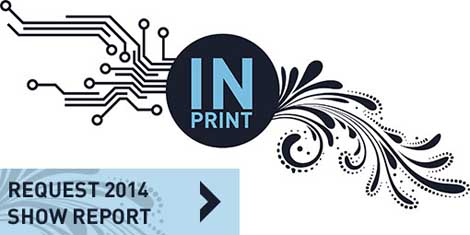InPrint Show organisers conducted research to 350 visitors and exhibitors onsite in Hannover, revealing key insight into where demand is taking technology into the future. The show itself was seen as a glimpse into the future of print technology, where it is being developed, deployed and integrated into new and exciting production lines.
At the first show an extensive research project was undertaken, powered by Bürkert, to ascertain the key drivers of growth for industrial print technology. This executive summary outlines the key themes contained within the report.
InPrint Show Launch Reveals Forces for Growth in Industrial Print
Growth Drivers
Growth for industrial print is powered by general consumer demand for products, coupled with the trend towards mass customisation of production. Industrial Print is currently valued at $100 Billion by I.T. Strategies and has a growth of $20 Billion which in expected in less than 10 years, largely driven by digital development. However his growth is not negatively affected by the increase of online retail and the general shift of marketing budgets towards online media.
What is Industrial Print?
But what is Industrial Print? The accepted definition of industrial print is ‘printing that is part of the process of manufacturing’. In this case it isn’t always ink that is printed! Industrial print plays a role in either the function or the decoration of a product. When you think about it – print is all about us, and is placed onto a wide array of surfaces, from inside your iPad and iPhone to the wood décor on your kitchen table, the ceramic tiles on your kitchen floor, the carpet in your hallway to the dashboard inside of your car, without it products would not work and would not look good.
Key Technologies at InPrint Show
Print technology shown at the InPrint Show included screen and pad printing, digital, inkjet and 3D Printing. The focus was on cutting edge technology that is innovative, precise, robust and durable.
Industrial print has to meet the highest of production standards. There is zero tolerance for even a slight imperfection. Print simply cannot fade in sunlight!
Unique Attendance
Yes. It worked because it attracted a different, focused and high quality group of people who came to the event with specific technical challenges and problems to solve. These people were a strategic level (71%) and they came predominantly (53%) from the manufacturing sector with only (28%) from the print industry. It therefore made sense that the discussions exhibitors had at the show were very different to that of a regular print trade show. Nearly 20% came from companies with over 1000 employees for example. Projects were commissioned and business was done, but with a unique sector of industry, leading us to conclude that the event broke new ground.
A Desire for Customised Solutions
The InPrint Show was not actually a ‘heavy metal’ show. Visitors attended for cutting edge technology and for ways to integrate this into their production line. Finished machinery whilst still relevant therefore, was not the main focus. Attendance came from diverse industries including automotive, aeronautical, ceramics, engineering, electronics, medical, pharmaceutical, packaging and textile. What united all visitors was their need to search for innovative print technology coupled with technical expertise that provided solutions to new production problems. This ranged from printing directly onto curved surfaces and cylinders to printing into and within electronic devices to surface imaging onto wood, metal, glass, textiles and plastics.
A Need for Technology for New Revenue Generation
What drove most people’s attendance to InPrint was to discover new technology in order to generate new revenue. Mass customisation is driving huge change within the industrial print sector – where technology can meet a more localised need for production and a more customised and sometimes personalised approach to manufacturing. Digital production provides options not possible with analogue technologies – this means short set up time, low stock inventory, allied to super quick design to production time and personalised potential for production. This is where local manufacturing can have an advantage over production that might take place in another continent. Time to market is rapidly increased. This re-shores production to Europe as digital technology enables manufacturers to respond more quickly to competitive market pressures.
A Blend of Technologies – Not Process Replacement
When the graphic sector transformed from analogue to digital printing output this displaced screen printing as the main process. For industrial print, radical displacement is much more unlikely to occur. For a start, the demands for production are more complex. For example, screen printing is so robust and high quality as well as being incredibly efficient and fast, it doesn’t make sense for digital to attempt to replace it. The digital opportunity for industrial print is to provide performance that is new and in most cases compliments the analogue technology. Some developing machinery is even a blend of both technologies. This enables the end-manufacturer to realise new possibilities without compromising on quality.
Europe is a Leader in Development and Integration
Europe is a leader in development and integration of technology for industrial print production. Key centres include the UK, Switzerland, Benelux, Italy and Germany. This isn’t to suggest that the rest of the world doesn’t adopt new technologies, but it does demonstrate that due to the competitive structure of the European marketplace, innovation is driving change to meet demand for competitive advantage.
100% Growth for Industrial Print
100% of respondents to the research believe that industrial print is growing – this endorses both the concept of the show and the focus that manufacturers have in technological development. The future for this exciting sector is positive for any business involved in development, integration and manufacture of industrial print. There is no doubt there is a hunger for improvement and innovation.
You can download the full show report and analysis as a PDF, by registering on the InPrint website at www.inprintshow.com



